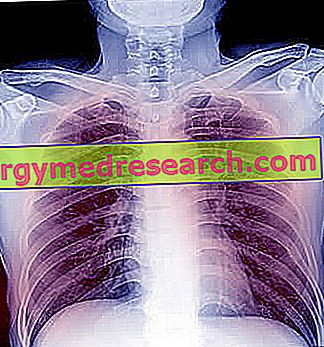Generality
Bronchopneumonia is a particular type of pneumonia, which involves inflammation of the bronchi, bronchioles and pulmonary alveoli.
At its origin there is usually a bacterial infection or a viral infection.
The main responsible bacteria are: Staphylococcus aureus, Streptococcus pneumoniae (or pneumococcus), Haemophilus influenzae and Klebsiella pneumoniae .

Bronchopneumonia classically leads to high fever, cough with phlegm, dyspnea, chest pain, rapid breathing and sweating.
Among the possible complications, the most feared is certainly sepsis.
Treatment depends on the triggering causes. Indeed, bacterial bronchopneumonia requires treatment other than viral bronchopneumonia.
Brief anatomical reference
Lower airways and pulmonary alveoli
The lower airways constitute that part of the respiratory system that begins at the level of the trachea and includes, subsequently, the bronchial tree - formed by bronchi and bronchioles - and the lungs .
Inside the lungs, reside small elastic pockets, called alveoli, in which the blood that reaches it "loads" with oxygen and "frees" itself of the carbon dioxide (waste product of the tissues).

A group of several pulmonary acini, with their respective terminal bronchioles, constitutes the smallest structure of the lungs visible to the naked eye: the pulmonary lobule (or lobule).
What is bronchopneumonia?
Bronchopneumonia is a type of pneumonia almost always of infectious origin, characterized by inflammation of the bronchi, bronchioles and alveoli.
In various medical texts, it is also called lobular pneumonia, due to the fact that the inflammatory state affects one or more pulmonary lobules.
BRONCOPOLMONITE AND POLOBONITE LOBARE
In addition to pneumonia, there are other types of infectious pneumonia.
A very common type, not to be confused with lobular pneumonia, is lobar pneumonia .
Lobar pneumonia generally affects one or more lung lobes, or the various portions that make up the lungs.
Causes
Bronchopneumonia is generally the result of a bacterial infection or a viral infection .
The main bacteria that can cause bronchopneumonia are:
- Staphylococcus aureus
- Streptococcus pneumoniae (or pneumococcus)
- Haemophilus influenzae
- Klebsiella pneumoniae
- Pseudomonas aeruginosa
As far as viruses are concerned, the viral agents that can cause bronchopneumonia are:
- Human respiratory syncytial virus
- Influenza A virus (or influenza virus type A) and influenza B virus (or type B influenza virus)
- The measles virus. In this case, bronchopneumonia is a complication of measles, whose triggering virus is a morbillivirus .
OTHER CAUSES
More rare forms of bronchopneumonia may arise as a result of:
- Ingestion of foreign material or food in the bronchial tree. In these cases, bronchopneumonia also takes the name of bronchopneumonia ab ingestis .
- Inhalation of poisonous gases.
- Malnutrition.
- Serious chronic diseases, such as tuberculosis.
- Surgery at the lower airway level.
RISK FACTORS
Bronchopneumonia affects certain categories of people more frequently.
For example, subjects such as: are particularly at risk
- Children under the age of 2 years. Children are particularly at risk of bronchopneumonia with viral origin
- People aged 65 and over
- Those who suffer from lung diseases, such as cystic fibrosis, asthma or chronic obstructive pulmonary disease (COPD)
- AIDS patients (or HIV)
- Those who, due to the use of chemotherapy or immunosuppressive drugs, have a weakened immune system
- Smokers
- Those who have a history of severe alcoholism
- Those who have severe difficulty swallowing
- Malnourished people
Symptoms and Complications
Regardless of the triggering causes, the symptoms and signs of a generic bronchopneumonia consist of:
- Fever between 39 and 40 ° C
- Cough with large production of phlegm
- Shortness of breath (dyspnea)
- Chest pain
- Quick breath
- Sweating
- Chills
- Headache
- Muscle pains
- Sense of recurrent fatigue
- Confusion or delirium (especially in older people)
- Loss of appetite
MACROSCOPIC ASPECT
The macroscopic characteristic typical of bronchopneumonia consists in the presence of multiple inflammatory foci, dispersed in one or both lungs (more frequent case).
Note: an inflammatory focus is a collection point for infectious microorganisms and inflammation cells.
HISTOLOGICAL ASPECT
From a histological point of view, bronchopneumonia involves the formation of a suppurative (or purulent) exudate, in the air spaces formed by the alveoli, bronchi and bronchioles.
WHEN TO REFER TO THE DOCTOR?

Represents a medical emergency, to be treated with the utmost speed, a bronchopneumonia characterized by severe chest pain, rapid breathing and confusion.
COMPLICATIONS
In case of inadequate treatment or in case of late diagnosis, bronchopneumonia can give rise to various complications, including:
- Sepsis (or septicemia ). In medicine, the term sepsis indicates a serious clinical condition that arises due to an abnormal inflammatory response, implemented by the body after the passage of pathogenic microorganisms in the blood.
The symptoms that characterize a condition of sepsis are: high fever, acceleration of cardiac rhythm, acceleration of breath, hypotension, confusion, pallor, chills and loss of consciousness.
- Pleurisy . It is the inflammation of the pleura, which is the membrane that covers the lungs and the cavities in which the lungs reside. The pleura has protective functions.
- Respiratory failure.
- Cardiovascular problems.
- Lung abscess.
Diagnosis
In general, the diagnostic pathway for the detection of bronchopneumonia begins with an accurate physical examination and a detailed medical history . Then, it continues with a blood count (blood test) and a chest radiograph ( RX-thorax ).
If after this series of evaluations the doctor still has doubts or has not yet fully understood the causes of bronchopneumonia, he could opt for the execution of further in-depth tests, such as:
- A CT scan of the thoracic organs . This survey provides three-dimensional images with more details than those provided by a chest X-ray. It is a mildly invasive procedure, as it involves exposing the patient to a certain amount of X-rays that are harmful to human health.
- A cultural analysis of sputum, or phlegm. This diagnostic test helps identify the organism responsible for the infection.
- A bronchoscopy . It consists of inserting, starting from the mouth and along the respiratory airways, an instrument equipped with a camera (endoscope), with which the doctor observes the cavities of the bronchial tree. It serves to provide further details on the characteristics of bronchopneumonia.
- Oximetry . Simple and immediate, it is a test for measuring oxygen saturation in the blood. For its execution, doctors use an instrument, the oximeter, which they apply to a finger or earlobe.
Low oxygen saturation indicates that breathing difficulties (dyspnea etc.) are of a certain severity and deserve immediate treatment.
EXAMINATION OBJECTIVE
During the physical examination, first of all, the doctor asks the patient to describe the symptoms experienced. Then, by means of a phonendoscope, it evaluates the respiratory capacities of the same, going in search of possible difficulties or anomalous sounds (rattling, screeching etc).
In general, the analysis by phonendoscope is quite precise and allows to establish which part of the lung or lungs is home to inflammatory hearths.
blood count
Blood counts show whether the infection is bacterial or viral. In fact, the blood count of a person with a bacterial infection has a high number of granulocytes (a type of white blood cell), while the blood count of a subject with a viral infection shows a high number of lymphocytes (another type of globules whites).
CHEST RADIOGRAPHY
Chest radiography is probably the most reliable diagnostic test for the detection of bronchopneumonia.
It is a minimally invasive procedure, as it involves exposing the patient to a small dose of X-rays.
Treatment
The treatment of bronchopneumonia varies according to the triggering causes .
If the origin of pneumonia is viral, doctors generally only recommend a complete rest period of about one or two weeks. In these situations, the prescription of antiviral drugs is rare and occurs only when the symptoms are very severe or when the disease shows no appreciable signs of improvement.
For cases of bronchopneumonia with bacterial origin, the situation is decidedly different. The doctors, in fact, prescribe an antibiotic treatment, as this is the only solution for the elimination of the infective agent. In such circumstances, it is essential that the patient completes the cycle of foreseen antibiotic therapies; otherwise, there is a high risk that bronchopneumonia will recur after some time (recurrence).
REMEDIES VALID AT ALL CIRCUMSTANCES
Regardless of the cause that induced bronchopneumonia, symptomatic remedies (ie effective against symptoms) are valid:
- Stay at complete rest
- Drink plenty of water and hot drinks. Adequate fluid intake prevents dehydration.
- Take paracetamol against fever
TREATMENT IN SERIOUS CASES
Severe bronchopneumonia requires hospitalization .
During a hospital stay for bronchopneumonia, doctors may have to resort to assisted ventilation and intravenous drug administration.
Prognosis
Generally, bronchopneumonia diagnosed early and treated in the right way has a positive prognosis.
On the contrary, a bronchopneumonia detected late or inadequately treated is at high risk of complications and can also have unpleasant consequences.
Prevention
People at risk of bronchopneumonia can reduce (or even prevent) the possibility of developing the aforementioned inflammatory condition, resorting to some vaccinations.
For viral bronchopneumonia, doctors recommend annual influenza vaccination .
For bacterial bronchopneumonia, however, they recommend the pneumococcal vaccine .
SIMPLE PREVENTIVE MEASURES
Wash your hands regularly, avoid smoking, do not abuse alcohol, stay away from people with pneumonia, exercise regularly, get enough sleep and eat in a balanced and healthy way: these are all easy to do and reduce the risk of develop a form of bronchopneumonia.



